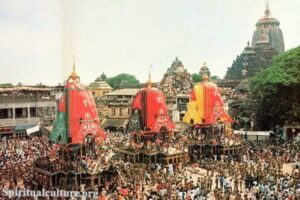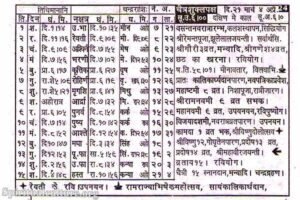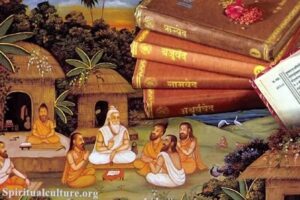In every human soul, there arises a question: What am I here for? Behind our routines and responsibilities lies a quiet hunger for purpose, for balance, for rightness in our actions and relationships. In Hinduism, this deep yearning is not ignored — it is named. It is called Dharma.
Dharma is more than a word. It is the heartbeat of Hindu philosophy, a thread that weaves through myth, ritual, family, nature, and society. It is at once cosmic law and personal guidance — universal truth and individual responsibility. Through the lens of Dharma, every moment becomes an opportunity to live in alignment with something greater than ourselves.
In this article, Spiritual Culture explores the meaning of Dharma in Hinduism — what it is, how it manifests, and how it shapes the way we live, love, and lead. This is not just about religion — it is about the soul’s deep desire for harmony in the dance of life.
Dharma: A Sacred Word with Many Facets
The Root of the Word
The Sanskrit word Dharma comes from the root “dhṛ”, meaning “to uphold,” “to support,” or “to sustain.” It implies that which holds everything together — the moral and cosmic glue of the universe. In the Bhagavad Gita, Krishna tells Arjuna:
“Whenever there is decline in righteousness and increase in unrighteousness, O Arjuna, at that time I manifest Myself.”
— Bhagavad Gita 4:7
Here, righteousness refers to Dharma — the sacred order that must be protected and restored when disturbed.
Dharma as Cosmic Order
In the Rig Veda, Dharma is not just about morality or behavior; it is the very law that upholds the heavens. The sun rises by Dharma. The seasons change by Dharma. Life is not random, but ordered — and that order is sacred.
Dharma as Duty
At the human level, Dharma becomes duty — but not in the sense of obligation alone. It is duty with meaning. One’s Dharma depends on many factors: age, role in society, stage of life, even temperament. For example:
- A student’s Dharma is to learn and cultivate character.
- A householder’s Dharma is to support family and contribute to society.
- A warrior’s Dharma is to protect the weak and uphold justice.
- A renunciate’s Dharma is to seek truth and detach from worldly desires.
These are not rigid roles but sacred responsibilities aligned with the greater good.
The Four Aims of Life: Where Dharma Stands First
In Hindu thought, life is guided by four Purusharthas (goals of human life):
- Dharma – Righteousness, duty, moral values
- Artha – Wealth, prosperity, means of life
- Kama – Desire, pleasure, love
- Moksha – Liberation, spiritual freedom
What is striking is that Dharma comes first. Even material success (Artha) and pleasure (Kama) are to be pursued within the bounds of Dharma. It is the compass by which all other pursuits are guided.
Dharma Across Life Stages (Ashramas)
Hindu tradition teaches that life flows through four stages — and each has its own Dharma.
1. Brahmacharya (Student Life)
Here, the focus is on learning, celibacy, discipline, and obedience to teachers. The Dharma of a student is to gain knowledge and build strong moral character.
2. Grihastha (Householder Life)
This is the stage of marriage, career, and social duty. It is considered the most important stage, for it sustains society. The Dharma here includes caring for family, earning ethically, and practicing hospitality.
3. Vanaprastha (Retirement / Forest Dweller)
Having fulfilled worldly duties, one begins to withdraw and reflect. The Dharma now becomes spiritual preparation, study, and guidance of the younger generation.
4. Sannyasa (Renunciation)
The final stage is one of total detachment — renouncing possessions, name, and even identity. The Sannyasi lives only for spiritual truth. His Dharma is inward: to seek union with the Divine.
Each stage has its own sacred tasks, and Dharma evolves with time — a dynamic balance, not a fixed rulebook.
The Mahabharata and the Question of Dharma
One of the deepest explorations of Dharma is found in the epic Mahabharata — especially in the Bhagavad Gita.
Arjuna’s Dilemma
As the warrior Arjuna stands on the battlefield, he sees loved ones on both sides. He is torn between his role as a warrior (Kshatriya Dharma) and his personal feelings. In this moment of inner crisis, Lord Krishna reveals that Dharma is not always easy — but it is higher than emotion or comfort.
“You have a right to perform your prescribed duties, but you are not entitled to the fruits of your actions.”
— Bhagavad Gita 2:47
Dharma means doing what is right, regardless of outcome. This is a spiritual maturity — action without attachment.
Dharma and the Caste System: A Controversial Intersection
The Original Intention
The ancient concept of Varna Dharma assigned roles based on qualities (guna) and work (karma), not birth:
- Brahmins – Teachers, priests, scholars
- Kshatriyas – Warriors, rulers
- Vaishyas – Merchants, farmers
- Shudras – Servants, laborers
Originally, this was meant to maintain social harmony — not create hierarchy.
The Distortion
Over centuries, this evolved into a rigid caste system, often hereditary and unjust. True Dharma, however, is not bound by caste. As Krishna says:
“I created the four orders according to quality and action.”
— Bhagavad Gita 4:13
The Gita emphasizes merit, not lineage. Modern Hindu thinkers like Swami Vivekananda and Mahatma Gandhi worked to revive the spiritual essence of Dharma beyond social divisions.
Dharma and Karma: The Ethical Dance
Dharma and Karma are sisters in the dance of life. Dharma guides what we should do; Karma is the result of what we do.
- When we live by Dharma, our Karma purifies.
- When we act against Dharma, we accumulate burden and suffering.
This is not punishment, but correction. The universe invites us to learn, to align, and to grow.
Living Dharma Today: Is It Still Relevant?
Absolutely. Even in the modern world, Dharma provides a moral compass amid confusion.
In Work
Acting with integrity. Honoring truth. Serving society through our gifts.
In Relationships
Practicing compassion, loyalty, respect, and forgiveness. Knowing when to speak and when to be silent.
In the Environment
Living with reverence toward nature. Choosing sustainability over greed. Protecting the Earth as a sacred trust.
In Crisis
Staying calm. Acting wisely. Holding to values even when tested. As the Gita teaches, the greatest Dharma may arise in our darkest moments.
Dharma in the Heart: A Personal Journey
Ultimately, Dharma is not just a doctrine — it is a journey inward. It asks:
“What is mine to do?”
“What is the right action, right now?”
“What serves truth, love, and the highest good?”
Sometimes Dharma is clear. Sometimes it is complex. But when we listen deeply, when we act not from ego but from soul, Dharma reveals itself.
Reflect and Reimagine
To live by Dharma is not to follow rules blindly. It is to live awake — attentive to what is right, what is needed, what is true. It means choosing alignment over ambition, harmony over haste, service over self.
In Hinduism, Dharma is not a cage — it is a calling. It does not limit; it liberates. It brings meaning to success and dignity to struggle.
So ask yourself, with reverence and courage:
“What is my Dharma in this moment?”
And how can I live it — fully, faithfully, and with love?”
In this quiet question lies a revolution of the soul.
— With you on this path,
Spiritual Culture




